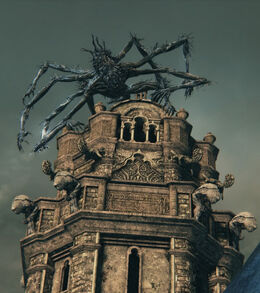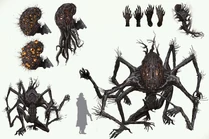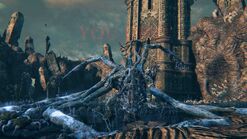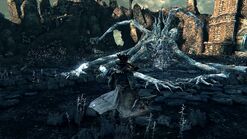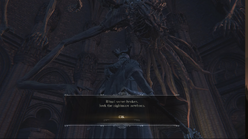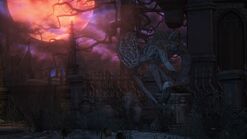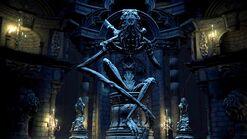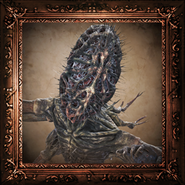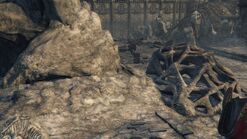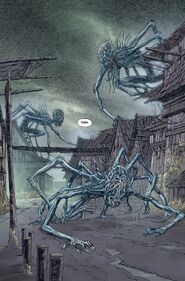- "Oh Amygdala! Oh Amygdala!
Have mercy on the poor bastard." - — Patches the Spider
Amygdala are Great Ones in Bloodborne. One appears as a boss in Amygdala's Chamber in the Nightmare Frontier. Meanwhile, others populate various locations throughout the game as non-playable characters, sometimes serving as methods of transportation between areas. Amygdala also appear as Chalice Dungeon bosses in the Cursed Pthumerian Defilement, Lower Loran, and Isz Gravestone.
Description[]
Amygdala are monstrous entities with spider-like bodies, a short tail and a head which is very similar to a part of the brain called the amygdala or amygdaloid body. Their many bulbous eyes bulge when they use arcane attacks. They have six-fingered hands on their seven arms, and reptilian talons on their two legs. Many also sport tendrils on their faces.
Locations[]
Non-boss variant[]
- Cathedral Ward: Holding on to Oedon Chapel.
- Grand Cathedral: Inside the abandoned church to the right of the cathedral, near the giant gate.
- Yahar'gul, Unseen Village: Many of them scattered around.
- Hunter's Nightmare: A corpse of an Amygdala is seen in the area with the stationary guns controlled by a Huntsman.
Boss variant[]
- Amygdala's Chamber: Past the elevator shortcut in the Nightmare Frontier.
- Cursed Pthumerian Defilement: 3rd Layer boss.
- Lower Loran: May appear as a possible boss.
- Isz Gravestone: May appear as a possible boss.
Lore[]
Amygdala[1] are Great Ones[2] that appear to be some of the most widely-revered of their kind. This is indicated by the numerous statues of them lining the Cathedral Ward and Yahar'gul, Unseen Village. A much larger statue, which appears to be part of a shrine, is located in the church of the Hypogean Gaol. Many Amygdala populate the world, dwelling atop the sides of various large buildings. One Amygdala came to inhabit an area in the Nightmare Frontier known as Amygdala's Chamber.[1]
Patches the Spider is seemingly one of the most devoted of this Amygdala's worshippers and offers sacrifices to his "God" through the use of the Tonsil Stone, transporting them into the Nightmare Frontier. However, after The Hunter slays the Amygdala, he expressed no remorse or anger, merely believing they "bestowed salvation" upon the entity.[1]
Strategy[]
Amygdala will primarily attack with sweeping attacks from its arms and stomping attacks if the player is close enough to one of its feet. It will also fire a laser like weapon from its eyes periodically if the player is attacking from the front. At approximately half health, it will begin leaping out of view and attempt to crush the player, which can typically kill a player in a single blow even at full health.
Its primary weak point is its head, which will lower to the ground periodically after certain smash and sweeping attacks, and can be struck with a weapon with long reach. Visceral attacks can also be performed on its head with a well timed charge attack on its head to stun it.
Amygdala is surprisingly susceptible, for a boss, to ranged weapon attacks to the head. The Hunter Pistol can damage approximately one-third its health with minimal Bloodtinge skill and 20 QS bullets. This is effective when Amygdala is near death, as it will remove a set of its limbs for its sweeping attacks, which will almost double its effective range.
Notes[]
- The Amygdala in the Nightmare Frontier drops the Ailing Loran Chalice when slain.
- The Amygdalas found grabbing the walls serve as a method of transportation to Nightmare realms:
- The one near the Grand Cathedral will take players to the Nightmare Frontier if players have the Tonsil Stone in their possession.
- The one in Cathedral Ward takes players to the Hunter's Nightmare if players have the Eye of a Blood-drunk Hunter in their possession.
Trivia[]
- In the Cathedral Ward, an Amygdala can grab and crush the player, immediately triggering a Frenzy status effect. Doing this grants one Insight. In The Old Hunters, this is how you get to the Hunter's Nightmare.
- In the Official Bloodborne Collector's Edition Strategy Guide book, the Amygdala are interchangeably called "False Gods". This is further supported by their theme music in the 2014 Alpha version of Bloodborne(an earlier version of Yahar'gul, Unseen Village music) which was called "False God Hymn", along with their Internal file name being '邪神 堕天使' which translates as 'Evil God Fallen Angel' and their Internal file name in the Alpha version being "FalseGod".
- Amygdala is named after groups of nuclei in the brain that process emotion, most commonly associated with fear.
- When Amygdala is killed, Patches the Spider will call it a "piteous bastard" on which you "bestowed salvation," but it does not seem certain why he addresses the being like this.
- Amygdala is also the Greek name for the "tonsils". It is one of two almond-shaped groups of nuclei located deep and medially within the temporal lobes of the brain in complex vertebrates, including humans. Shown in research to perform a primary role in the processing of memory, decision-making, and emotional responses, the amygdalae are considered part of the limbic system. In one study, electrical stimulations of the right amygdala induced negative emotions, especially fear and sadness. In contrast, stimulation of the left amygdala was able to induce either pleasant (happiness) or unpleasant (fear, anxiety, sadness) emotions. Note that the Tonsil Stone item allows the player to interact with the Amygdala.
- It might get its name from the Horsfieldia amygdalina, a tree in Myristicaceae family, or nutmeg family because Amygdala's head and skull bear a striking similarity to the red arils (mace) surround the nutmeg. Nutmeg and mace are very popular spices in the Victorian era cuisine. In Elizabethan times, nutmeg was believed to ward off the plague. And nutmeg overdose will cause Nutmeg poisoning, which is also reported to induce hallucinogenic effects, such as visual distortions and paranoia.
- Alternatively, it could also reference the palatine tonsils, which are almond-shaped, porous bulbs located in the throat. They function as one of the first lines of defense for the immune system, filtering bacteria. Amygdalitis (or tonsilitis) is caused by the palatine tonsils getting infected, which makes them secrete a pus-like fluid. The pus and debris later solidifies, then naturally gets detached from the amygdalan crypts (the pores on their surfaces), and they are known as tonsil stones or tonsiliths.
- Its strategy in the third stage of the fight, ripping off its arms and using them as weapons, is similar to the one used by The Last Giant in Dark Souls 2.
- Amygdala's head vaguely resembles that of the Mi-go, extraterrestrials from the planet Yuggoth in H.P. Lovecraft's work. In contrast, the Mi-go do not have eyes.
- The Amygdala around Yharnam are invisible until the player either gains enough Insight or until the Blood Moon Cycle. This may be an homage to the invisible offspring of Yog-Sothoth as described in H.P. Lovecraft's story The Dunwich Horror.
- A Lore Note at Byrgenwerth states "When the red moon hangs low, the line between man and beast is blurred. And when the Great Ones descend, a womb will be blessed with child." Interestingly, the same states is applied for the Amygdalae in the artbook. Arianna gets pregnant during Blood Moon and a lesser Amygdala lives just outside the Oedon Chapel. This begs the question whether Oedon or the Amygdala blessed her with a child.
- The Japanese name for them is 'アメンドーズ'.
- Pronouncing it (Amendōzu) produces a word similar to 'almonds', however, the current Japanese spelling of almonds is 'アーモンド'. It is, however, very similar to the Portuguese pronunciation for 'almonds': 'amêndoas'.
- The old Japanese word, for almond, is: '扁桃'. Adding '体' to it, making '扁桃体', creates the word 'amygdala'.
- The Tonsil Stone, in Japanese, is: '扁桃石'. Translated, it can mean: 'Almond Stone'.
- Pronouncing it (Amendōzu) produces a word similar to 'almonds', however, the current Japanese spelling of almonds is 'アーモンド'. It is, however, very similar to the Portuguese pronunciation for 'almonds': 'amêndoas'.
Gallery[]
Videos[]
Music[]
| Great Ones |
|---|
| True Great Ones |
| Amygdala • Oedon • Moon Presence • Kos • Orphan of Kos • Mergo & Mergo's Wet Nurse • Brain of Mensis • Ebrietas, Daughter of the Cosmos |
| Faked Great Ones (Kin) |
| Rom, the Vacuous Spider • Celestial Emissary |
| Failed Great Ones |
| The One Reborn • Living Failures |
References[]
- ↑ 1.0 1.1 1.2 Bloodborne
- ↑ Amygdalan Arm description.

